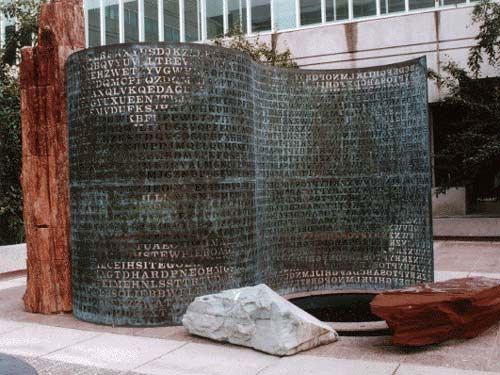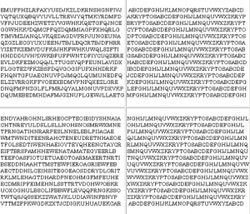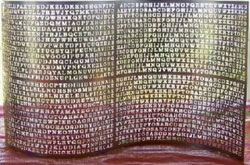
 Sculpture News at SculptSite.com
Sculpture News at SculptSite.com
Jim Sanborn Sculpture |
 |
| Wired.com By Kim Zetter Kryptos Artist to Reveal Rare Clue to Baffling CIA SculptureKryptos sleuths may finally get some help cracking the CIA sculpture that has confounded amateur and professional cryptographers for two decades. Artist Jim Sanborn, who created the cypher sculpture in 1990 for CIA headquarters in Langley, Virginia, plans to release a new clue to help puzzle detectives solve the last 97 characters of his masterpiece. The new clue is to be revealed in a New York Times article this weekend, to mark the 20th anniversary of the sculpture, which was dedicated Nov. 3, 1990. It will be the first clue Sanborn has revealed in four years, after he corrected a typo in his sculpture in 2006 to keep crypto detectives from being derailed in their search for solutions. Sanborn wouldn't disclose the clue to Threat Level but said only cryptically that it will "globalize" the sculpture. Asked if this meant it would take the sculpture off the CIA grounds and out of the United States, he conceded it would. "I personally think it's a significant clue," he said. "I'm throwing it out there. It just makes that many fewer characters people have to figure out." Sanborn said he'd been thinking about revealing a clue for a long time but couldn't decide on the right occasion until the 20th anniversary and his birthday coincided in the same month. "I don't have that many decades... left in me," the 65-year-old artist said. The 12-foot-high, verdigrised copper, granite and wood sculpture is inscribed with four encrypted messages, three of which have been solved. The sculpture's theme is intelligence gathering (Kryptos is Greek for "hidden"). It features a large block of petrified wood standing upright, with a tall copper plate scrolling out of the wood like a sheet of paper. At the sculpture's base is a round pool with fountain pump that sends water in a circular motion around the pool. Carved out of the copper plate are approximately 1,800 letters, some of them forming a table based on an encryption method developed in the 16th century by a Frenchman named Blaise de Vigenere. Sanborn sells replicas of the sculpture for $150 at the International Spy Museum in Washington, D.C., and other locations (see photo below of prototype taken at Sanborn's home in 2006). In 1998, CIA analyst David Stein cracked three of the four messages using paper and pencil and about 400 lunch-time hours. Only his CIA colleagues knew of his success, however, because the agency didn't publicize it. A year later, California computer scientist Jim Gillogly gained public notoriety when he cracked the same three messages using a Pentium II. The first section is a poetic phrase that Sanborn composed. The second hints at something buried: "Does Langley know about this? They should: It's buried out there somewhere." The third section comes from archaeologist Howard Carter's diary describing the opening of a door in King Tut's tomb on Nov. 26, 1922. But for 20 years, the fourth section of the puzzle, consisting of 97 characters, has remained unsolved. The clue Sanborn spills this week may help untangle the message, but won't necessarily solve the puzzle. "It doesn't mean you're going to understand it or it will be completely laid out before you," he said. "It will not be plain as day, ever." This is because the text hides a riddle, which Sanborn has said requires sleuths to be on the CIA grounds to solve it. "In part of the code that's been deciphered, I refer to an act that took place when I was at the agency and a location that's on the ground of the agency," Sanborn said during a 2005 interview with Wired.com. "So in order to find that place, you have to decipher the piece and then go to the agency and find that place." The riddle may refer to something Sanborn buried on the CIA grounds at the time he installed the sculpture. Decrypted parts of the sculpture give latitude and longitude coordinates (38 57 6.5 N, 77 8 44 W), which Sanborn has said refer to "locations of the agency." The full cryptographic code from all four sections of the Kryptos sculpture. Elonka Dunin Only two other people were said to know the solution to Kryptos. CIA cryptographer Ed Scheidt helped Sanborn choose and alter the coding techniques for the sculpture. And former CIA director William Webster received a sealed envelope containing the solution at the sculpture's dedication. In 2005, Sanborn revealed to Wired.com that a decrypted line in the sculpture referred to Webster: "Who knows the exact location? Only WW." But Sanborn also said at the time that Scheidt, now a retired chairman of the CIA's Cryptographic Center, and Webster only thought they knew the solution. "Well, you know, I wasn't completely truthful with [Webster]," Sanborn said. "And I'm sure he realizes that. I mean that's part of trade craft, isn't it? Deception is everywhere... . I definitely didn't give him the last section, which has never been deciphered." The encrypted sections include intentional spelling errors and misaligned characters set higher on a line of text than characters around them. But in 2006, Sanborn realized the sculpture contained an inadvertent error, a missing "x" that he mistakenly deleted from the end of a line in section two, a section that was already solved. He discovered the omission while doing a letter-by-letter comparison of the plain text and coded text in preparation for a book about the life of the sculpture. The "x" was supposed to signify a period or section-break at the end of a phrase. Sanborn removed it for aesthetic reasons, thinking it wouldn't affect the way the puzzle was deciphered. In fact it did. What sleuths had until then deciphered to say "ID by rows" was actually supposed to say "layer two." The correction hasn't helped anyone solve the rest of the puzzle, however, in the subsequent four years. In conjunction with the new clue release, Sanborn is launching a website for the sculpture to provide an automated way for people to contact him with their proposed solutions to the puzzle. Over the years, numerous people who were convinced that they'd solved the final puzzle section have contacted him. One woman even showed up at his secluded home on an island. Most of the solutions people have offered have been wildly off-base. Sanborn says that with the launch of his new site, anyone who thinks they've solved the last section will have to submit what they believe are the first 10 characters of the final 97 before he will respond. Sanborn has produced a number of other cypher sculptures, in addition to Kryptos. But his most recent work has focused on recreating the 1939 experiment at the Carnegie Institution of Washington that resulted in the first fission of uranium using a particle accelerator. His working accelerator can be seen at the Museum of Contemporary Art in , Colorado. |
 Jim Sanborn creates unique work, that is fascinating and seems to stand the test of time. It most definitely has a strong message and I like his designs. |
 The full cryptographic code from all four sections of the Kryptos sculpture. Elonka Dunin |
 |
More Sculpture News ....
Submit your SCULPTURE NEWS.
It's easy, just send us an e-mail
(click on Submit News in the left menu) with your pertinent information along with images, we'll take care of the rest. Sculpture makes our world a much better place in so many ways!
SculptSite.com, along with Sculptors and their creative genius all helping to bring the beauty and message of Sculpture to a hurried world.

